Oshkosh
![]()
Oshkosh |
|
by Alfred Scott
This article appeared in the September 1993 Falco Builders Letter. |
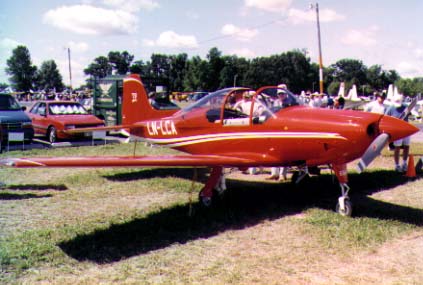
What's a Norwegian Falco doing at Oshkosh?
Cats have a strange way of showing affection. They'll kill a rabbit, squirrel or bird and then arrange the choice pieces and organs in an ornate display at the doorstep of their most beloved human. To us it's disgusting, but the pieces are all carefully laid out, often in symmetrical arrangements of innards, guts and gristle. To the cat, they are offering a feast of the choicest parts, to us it's all something we'd rather not look at.
I thought about cats as I wandered among the show planes of Oshkosh. Here and there are displayed the innards and engine compartments of otherwise attractive airplanes. Who really wants to look at the aeronautical intestines, gizzards and craw of an airplane?
There was an SX-300 at Oshkosh that someone had spent 11,000 hours a-building, quite obviously salivating at the glories of winning the coveted Grand Champion award. It was an airplane whose only purpose was to win an award. The rocker arm covers were gold-plated. The inside of the cowling was painted to match the exterior and waxed to a high gloss. Every screw that could be polished was polished. The aluminum tubing for the instrumentation was polished to such a high gloss that it appeared to be chrome-plated, and it was painfully obvious that the builder had invented parts just so they could be polished.
For example, all airplanes have the problem of how to get wires from the firewall to the alternator. All sensible builders just bundle the wires neatly and ty-wrap them in place. But not on this SX-300. Oh, no. They ran an aluminum tube along the inside of the cowling above the Camloc receptacles. Each end of the tube was flared-nice touch, don'tcha think, judge, 'cause that way the ends of the tube won't cut the wires, see-and then the entire tube and cable clamp assembly was polished-how 'bout that, judge, see all that polishin'? Eleven thousand hours of building, polishing and inventing parts to be polished. I wanted to bore-scope the tube to see if he had polished the inside.
It was just like cats. All these pieces of airplanes that you'd rather not see laid out in an elaborate display. Some builders show up at Oshkosh so intent on winning The Big Prize that they bring along an entire Amway platoon to wax and polish the plane, which they stake out with flagged ropes, and erect stands to hold the photo albums. To fit in with this crowd, Lyndon Johnson should have put makeup on his belly before he showed the world his gall bladder incision.
Fanie Hendriks came all the way from South Africa to see the Oshkosh show, but more particularly he came to see a real Falco, something he'd only seen in photos and major parts of which occupied his workshop. He'd heard his friend Brian Nelson tell of flying in a Falco and seeing them at the Great Oyster Fly-In, but he'd never seen one in real life.
Thus, imagine the surprise of Fanie Hendriks wandering among the generic 'glass of Oshkosh and seeing a red Falco with Norwegian tail numbers touch down and taxi quietly into the grass. He knew immediately that Falco LN-LCA belonged to Bjoern Eriksen. He had hoped to see a Falco, but never Bjoern Eriksen's Falco. He lives in Norway, for goodness sakes.
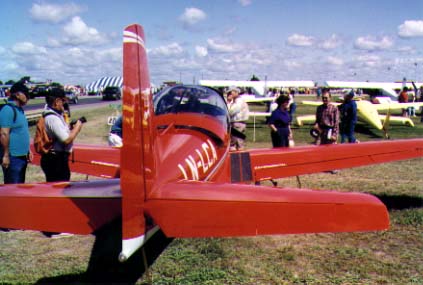
Norwegian Wood.
It took Eriksen 24 hours of flight time to get from Bodoe, Norway, to Oshkosh, Wisconsin. He had installed a 45-gallon ferry tank in the right seat, there was an HF radio mounted at the base of the stick and a GPS sat atop the glareshield. Other than that, it was a perfectly stock Falco that was flawlessly and lovingly built.
There wasn't a single part that was polished for the sake of appealing to an airshow judge, and Eriksen had not invented a single component to fulfill a fancied lust of airshow judges for glitz and glitter. At one point, I spied a judge going over the Falco, and I asked him if the ferry tank would count against the airplane in the judging standards. "Quite the opposite," he said. "It shows the airplane was flown here."
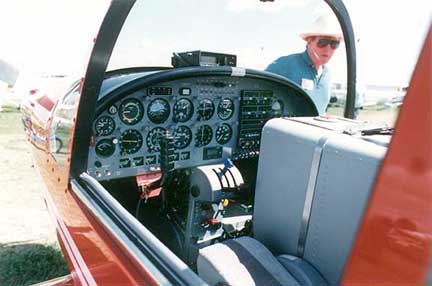
"I'm rather surprised to see you here," I told Eriksen when I first saw him. "That was the idea," he grinned, and later he admitted that this had been a long-planned trip concocted in deliberate secrecy from Dr. Ing. Alfredo Scoti. He had planned to come the year before but was unable to get vacation time from his company during the Oshkosh convention. There were some last-minute administrative problems as the FAA instituted a moratorium on bringing Experimental aircraft into the U.S. The EAA was very helpful and got the FAA to lift the moratorium for amateur-built aircraft. (The moratorium, which has since been lifted, was instituted because of the flood of inexpensive surplus Eastern-block jets being imported by warbird collectors.)
On arrival at Oshkosh, Bjoern called his wife Torill back in Norway and told her to get a ticket on KLM and that she could not miss the show. Torill was there when I saw them on Monday, and both of them were decked out in matching "Flight of the Falco" teeshirts with a map of the route of flight. Hmm. You'd have to make those teeshirts well in advance. Norwegians are a frugal lot-maybe Bjoern didn't want to squander the money on an airline ticket until he was safely across the Atlantic.
It was quite a long flight, over lots of water, but Bjoern said it was all routine, as the trip home later proved to be. The longest leg was from his home of Bodoe, which is above the Arctic Circle, to Iceland. That was 1,000 miles, and it took about six hours, if I recall correctly. With the GPS, Bjoern knew where he was at every moment and says he would never consider a flight like this without the GPS. He also had an HF radio with the antenna wire strung along the aft wing spar of the right wing, so communication was no more of a problem than navigation.
It didn't surprise anyone that Eriksen's Falco was in contention for an award. He had previously won the top award at the Wroughton Fly-In in England. Charles Gutzman, whose Falco had earlier won Reserve Grand Champion, circled Eriksen's Falco and said it was better than his plane. And a judge commented to me that it was the best Falco he had seen. In the end, if you haven't already heard, Bjoern Eriksen walked off with the Grand Champion (Plans-Built) award.
No airplane is without flaws, but in going over the Falco, there were only two things that I could point to and say, "See, that's not perfect." The aft third of the wing fillets were made of plywood, and if you sighted down the wing fillets at just the right angle, you could see that there was an area in which the ever-changing shape became a flat-wrapped section. And on the fairing around the bottom of the windshield, if you caught the reflection of the sun at just the right angle, you could see the weave of the fiberglass. That's how near perfect the airplane was.
The thing that 'said it all' to me was how the Dzus fasteners on the cowling doors worked. It's difficult to get these to work properly on a Falco, and they're normally tight and difficult to turn. But on Eriksen's Falco, they all turned easily, and every one was exactly the same. And when you looked in the engine compartment, it was spotless. I asked Eriksen if he had cleaned the engine compartment. He said he had not, that he had just flown across the Atlantic and parked the airplane. In looking at it closely, I could see that there was a very slight haze of carbon dust on the top of the induction filter that came from the exhaust line of the vacuum pump.
After he won the award, I asked Eriksen if he didn't stop in Canada and spend a day cleaning the airplane in preparation for Oshkosh. Nope, he said, he just flew across the ocean and landed at Oshkosh. Each morning, he went over the airplane with a soft cloth to remove any dust, but that was it. "But what about bugs on the leading edge?" I asked. "At ten thousand feet over the Atlantic, there are no bugs," he said.
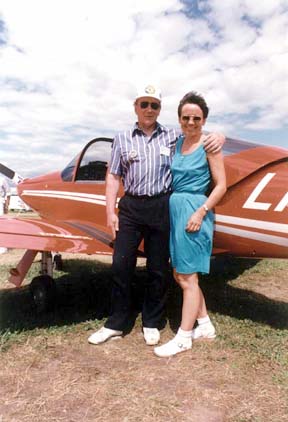
Bjoern and Torill Eriksen with their Grand Champion Falco.
Thus it was that Bjoern Eriksen, who built the Falco in a single-car garage in one of the more frozen climes of Europe, became the first international homebuilt to win the coveted Grand Champion award at Oshkosh, and the first to be built above the Arctic Circle. (The Swearingen ended up winning third place among kit-built aircraft.) Eriksen also set a record among Falco builders for the longest distance flown to get to Oshkosh.
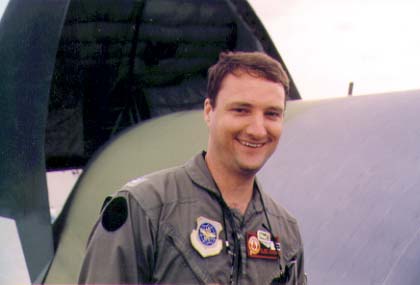
Blake Jessen
Another unofficial Falco-builder record fell at Oshkosh, this one for flying the biggest airplane to Oshkosh. The previous record was held by Nick Tramantano, who flew a Flying Tigers DC-8 cargo plane to Oshkosh. Blake Jessen, however, has set a record that will be quite difficult to beat when he arrived at Oshkosh flying a C-5A Galaxy. Blake gave Jack Amos, Cecil Rives and me a VIP tour of the machine, which is enormous beyond description. Blake used about 25,000 gallons of fuel for the one-way flight from Travis Air Force Base in California. Let's put that in perspective: his round-trip fuel consumption is enough for Bjoern Eriksen to fly from Norway to Oshkosh 160 times.
I arrived at Oshkosh by Falco, Cherokee and good fortune. Jack Amos and I left Richmond in the Corporate Disgrace on a flight that seems as ordinary as any other. About 45 minutes out, the engine suddenly went very rough. I quickly switched tanks, checked the mags, pulled carburetor heat on and then flicked through the four cylinders with the Alcor CHT/EGT. One cylinder was cold, and perhaps a second one as well. This was obviously not a problem that was going to clear up with some knob twiddling.
Only a minute or two before, we had crossed the Shenandoah Valley airport, at Harrisonburg, Virginia. We were at 8,000 feet and the weather was clear, so I turned back to the airport while Jack scurried about looking for the airport frequency.
I've always operated on the understanding that engines rarely fail without previous warning and that the vast majority of engine failures occur on a power change. So on those few occasions when I've had a problem, I always maintain altitude and fly over the airport, then reduce power and land. This is the approach I used here, and I throttled back only when I was safely within gliding range of the airport.
Other than the conversation with the airport unicom, the rough-running engine and the high approach speed I used, it was a normal landing, and we taxied by the airport fire truck with the engine stumbling irregularly. I had told them that I didn't need any emergency equipment standing by, but they just had to fire up the truck anyway. It was the biggest excitement the airport had seen for months, and you wouldn't want to spoil it all by being too cool.
Oil was streaming from the right rear cylinder, and we left the Falco in the care of the local FBO, Classic Air, while Jack and I continued on in a rented Cherokee 140. The Cherokee was a "hot" machine, with a new 160 hp engine and speed-mod wheel pants. My Lord, it was slow. On most of the trip, we rarely saw more than 90 knots groundspeed, and once or twice in a thermal actually saw 600 fpm on the rate-of-climb.
On our return, we learned that the Falco's engine had swallowed an exhaust valve and that the piston and cylinder were a complete mess. It took several weeks to get a new jug, but it's back in the air now.
How long it would have run is anyone's guess, but we were losing oil out of the cylinder and at some point the engine would have seized from lack of oil. Classic Air's Richard Kiser said we were only five minutes from becoming "a short-winged glider" when we landed. Everyone agrees that it could not have happened at a better place. Ahead of us were the Allegheny mountains where there's almost no place to land, and further on we would have crossed Lake Michigan. For a bit of bad luck, it certainly came at a lucky time.